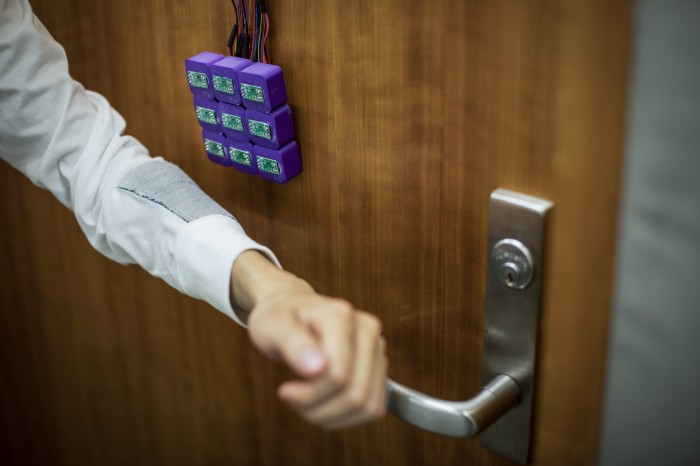Your Next Password May Be Stored in Your Shirt Cuff

If you love gadgets so much that you imagine a future where even your wardrobe is connected, but you’re irritated by current offerings that still include chunky electronics, don’t give up hope just yet.
Researchers at the University of Washington are trying to simplify so-called smart fabrics by focusing on magnetized textiles that can store small amounts of data readable by a magnetometer, including the ones inside most smartphones. It’s potentially useful for invisibly labeling your stuff, or using a shirt or bracelet in place of a password or key card. The researchers also used magnetized thread embroidered into gloves as a gesture controller for the phone, without need for any electronics or batteries on the fabric itself. A paper on the project was presented this month at a conference on human-computer interfaces in Quebec City, Canada.
Connected fabrics and clothing have been around for many years, touted by artists, startups, and, in some cases, large companies (see Google’s Project Jacquard and its partnership with Levi’s). They still haven’t caught on with most consumers, though, for a variety of reasons, ranging from high prices for limited functionality to concerns about durability (since, presumably, you’d like to eventually throw even a connected garment in the wash).
Yet Shyam Gollakota, an associate professor and director of the UW Networks and Mobile Systems Lab, and Justin Chan, a graduate student in the lab, think their work can be useful for making smart clothing and accessories because it focuses on the possibilities for magnetizing fabric with readily available, fairly inexpensive, unobtrusive conductive thread. And though the strength of the thread’s magnetic field declined over the course of a week, they found that they could use an Android smartphone to read data encoded on it even after washing, drying, and ironing the fabric.

“It’s extremely durable,” says Chan, and the thread can be reprogrammed, too.
The researchers embroidered on fabric with the conductive thread and used magnets to encode short strings of 0s and 1s as positive and negative magnetic polarities. They could then place a smartphone near this magnetized, data-filled fabric and read what it said with an app they built for that purpose, taking advantage of the magnetometer that phones use for orientation applications. A demo video shows how a shirt with a magnetized-thread patch on it could be used to unlock a door equipped with magnetometers.
In addition to making swatches of magnetized fabric, they made some prototype accessories like a tie, belt, and bracelet that could be programmed.
The researchers also embroidered a pair of gloves with magnetized thread and found that a nearby smartphone could measure gestures like finger swipes and taps by looking at changes in the magnetic field in three dimensions as the gesture was performed.
The work has a way to go before it could be incorporated into your shirt or pants. For instance, while the researchers could get a smartphone to recognize six gestures made wearing gloves with magnetized-thread fingertips, it only recognized them 90 percent of the time. (Gollakota, who in 2014 was named to MIT Technology Review’s annual list of 35 innovators under the age of 35, says accuracy jumps to 99 percent when the number of gestures is limited to four.)
And while the magnetized thread could be embroidered into a shirt cuff and encoded with enough data to act as an alternative to an RFID tag, you couldn’t, say, store your MP3 collection that way. Gollakota says he and Chan are now trying to figure out how to store more data on the fabric.
Keep Reading
Most Popular
Large language models can do jaw-dropping things. But nobody knows exactly why.
And that's a problem. Figuring it out is one of the biggest scientific puzzles of our time and a crucial step towards controlling more powerful future models.
How scientists traced a mysterious covid case back to six toilets
When wastewater surveillance turns into a hunt for a single infected individual, the ethics get tricky.
The problem with plug-in hybrids? Their drivers.
Plug-in hybrids are often sold as a transition to EVs, but new data from Europe shows we’re still underestimating the emissions they produce.
Stay connected
Get the latest updates from
MIT Technology Review
Discover special offers, top stories, upcoming events, and more.